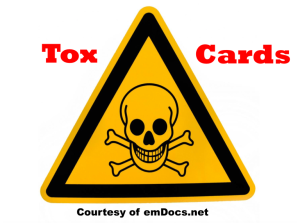Authors: Clay Long, MD (Emergency Medicine Resident, Atrium Health’s Carolinas Medical Center); Christine Murphy, MD (Emergency Medicine Attending, Medical Toxicologist, Atrium Health’s Carolinas Medical Center) // Reviewed by: James Dazhe Cao, MD (@JamesCaoMD, Associate Professor of EM, Medical Toxicology, UTSW / Parkland Memorial Hospital); Alex Koyfman, MD (@EMHighAK); Brit Long, MD (@long_brit)

Case:
A 16-year-old male with no prior medical history presents to the emergency department via emergency medical services (EMS) for evaluation of altered mental status. EMS reports that the patient became confused and diaphoretic while in local high school class before vomiting multiple times. The patient’s emesis reportedly contained an unknown number of red gel capsules. Prehospital, his blood glucose was within normal limits, and he was reportedly hypertensive and tachycardic with a GCS of 13 for inappropriate speech.
Questions:
- What over-the-counter medications contain dextromethorphan?
- What potentially toxic substances is dextromethorphan commonly found in combination with?
- What potentially serious or life-threatening conditions can occur from dextromethorphan overdose?
Background:
- Dextromethorphan is an antitussive commonly found in many over-the-counter cough and cold medications
- Chemistry: Dextromethorphan is a synthetic codeine analogue. It contains an alkylated amine attached to a cyclohexane ring like ketamine and phencyclidine (PCP).
- Mechanism of action: At standard dosing, dextromethorphan has primarily sigma opioid receptor agonist properties which account for its antitussive properties.1 However, it also acts as a serotonin (5-HT2 receptor agonist),2 N-methyl-D-aspartate (NMDA) receptor antagonist (like ketamine), and adrenergic neurotransmitter reuptake inhibitor in supratherapeutic dosing.3
- Metabolism: Undergoes hepatic demethylation via CYP2D6 to its active metabolite dextrorphan, the D-isomer of levorphanol (μ-opioid receptor agonist)4
- Dextrorphan has an even greater affinity for the NMDA receptor than dextromethorphan and also induces dissociative effects and hallucination in humans
- Due to genetic polymorphisms, some individuals have rapid CYP2D6 activity (ultra-rapid metabolizers) and others have poor enzyme activity (poor metabolizers)
- Ultra-rapid metabolizers accumulate a large amount of dextrorphan quickly and are more likely to develop wanted effects of euphoria and hallucinations. Poor metabolizers tend to experience more of the negative side effects like sedation and dysphoria.5
Epidemiology:
- According to the National Poison Data System (NPDS), the annual rate of calls to poison control centers regarding intentional dextromethorphan abuse tripled from 2000 (n=696) to 2006 (n=2883)6
- The highest rate of calls regarding abuse during this period was observed among adolescents 14 to 17 years old with a mean of 1761 calls per year6
- Commonly abused medications that contain dextromethorphan include Coricidin® products, Nyquil™ and Robitussin®7
- Using dextromethorphan to get high has been called Robotripping, and there are many slang names for drugs with dextromethorphan in them such as Skittles, Triple C,” “Dex,” “Orange Crush,” “Red Devils,” and “Poor Man’s PCP”
- Over 100 products contain dextromethorphan worldwide
- Almost always found in combination with other over the counter medications such as acetaminophen, antihistamines, and alpha-agonists8
- These other medications can also cause toxicity. Chlorpheniramine, for example, is an antihistamine found in Coricidin® products that also has serotonin reuptake effects and can contribute to the development of serotonin syndrome.
Clinical Effects:
Acute Toxicity
- Neurobehavioral effects: Rotary nystagmus, euphoria, hallucinations, dissociation, agitation, dysphoria, sedation, seizures, coma
- Cardiovascular effects: Hypertension, tachycardia
- May precipitate serotonin syndrome, particularly when co-ingested with other serotonergic substances, resulting in symptoms such as hyperthermia, diaphoresis, rigidity, clonus, hyperreflexia, and altered mental status2
- Agitation can lead to rhabdomyolysis
Chronic Toxicity
- Neurobehavioral effects: Toxic psychosis, cognitive deterioration, intense cravings, and dysphoria with abrupt cessation
- Dextromethorphan is commonly produced as hydrobromide salt which is neurotoxic and has a long half-life. Accumulation of bromide in chronic use has been reported in case studies and can lead to symptoms of fatigue, ataxia, headache, and memory loss9,10
Withdrawal
- Limited reports of withdrawal symptoms describe vomiting, diarrhea, anxiety, restlessness, dysphoria, and anxiety lasting days to weeks11
Management:
- Laboratory evaluation
- Should include acetaminophen concentrations due to number of combination products
- Recommend creatinine phosphokinase concentrations in patients with moderate to severe agitation
- False elevations in serum chloride concentrations can occur with certain autoanalyzers due to interference by the bromide salt in many of these compounds9,10
- Additionally, while not useful in most situations, dextromethorphan can cause a false positive on the PCP screen of many urine drug screen immunoassays.
- Treatment is primarily supportive
- Benzodiazepines first line for seizure(s) or agitation
- If concerned for serotonin syndrome, stop the drug! Benzodiazepines are used for initial treatment in moderate serotonin syndrome, and you can consider cyproheptadine for moderate to severe serotonin syndrome. (Read more on this in the EMDocs on Serotonin Syndrome and Neuroleptic Malignant Syndrome: Pearls & Pitfalls)12
- Intravenous fluids for rhabdomyolysis
- Benzodiazepines, cooling measures, and if needed, intubation and paralysis for hyperthermia
Case Follow-up:
The patient received benzodiazepines in the emergency department for agitation but remained hemodynamically stable without further deterioration of his mental status. Acetaminophen was undetectable. His hypertension and tachycardia improved, and he did not develop seizures or findings concerning for serotonin syndrome during his course. He was admitted for observation overnight and discharged the following day.
Clinical Pearls:
- Dextromethorphan is a common and easily available over-the-counter medication that is abused for its psychoactive properties, particularly in adolescent populations
- It is a direct serotonin receptor agonist and has hyperadrenergic properties that can lead to life threatening serotonin toxicity in overdose/when combined with other serotonergic agents
- Always consider potentially toxic coingestants along with DXM overdose
- Antihistamines
- Alpha-agonists
- Acetaminophen
- Patients who exhibit chronic use may experience lingering neurologic effects due to accumulation of neurotoxic bromide
References:
- Shin EJ, Nah SY, Chae JS, Bing G, Shin SW, Yen TP, et al. Dextromethorphan attenuates trimethyltin-induced neurotoxicity via sigma1 receptor activation in rats. Neurochemistry International. 2007;50(6): 791–9.
- Schwartz AR, Pizon AF, Brooks DE. Dextromethorphan-induced serotonin syndrome. Clin Toxicol (Phila) 2008;46:771–3.
- Brown GR, McLaughlin K, Vaughn K. Identifying and treating patients with synthetic psychoactive drug intoxication. JAAPA. 2018;31(8):1-5.
- “Dextromethorphan (PIM 179)”. inchem.org. Archived from the original on 2017-03-10. Accessed 4/20/2021.
- Zawertailo L, Kaplan H, Busto U, Tyndale R, Sellers E. Psychotropic effects of dextromethorphan are altered by the CYP2D6 polymorphism: a pilot study. J Clin Psychopharmacol. 1998;18(4):332-7.
- Sara Karami, Jacqueline M. Major, Silvia Calderon & Jana K. McAninch (2018) Trends in dextromethorphan cough and cold products: 2000–2015 National Poison Data System intentional abuse exposure calls. Clinical Toxicology. 2018;56:7, 656-663.
- Schwartz RH. Adolescent abuse of dextromethorphan. Clin Pediatr (Phila). 2005;44(7):565–568.
- Morris H, Wallach J. From PCP to MXE: a comprehensive review of the non-medical use of dissociative drugs. Drug Test Anal. 2014;6(7-8):614–632.
- Olives TD, Boley SP, LeRoy JM, Stellpflug SJ. Ten Years of Robotripping: Evidence of Tolerance to Dextromethorphan Hydrobromide in a Long-Term User. J Med Toxicol. 2019 Jul;15(3):192-197.
- Ng YY, Lin WL, Chen TW, Lin BC, Tsai SH, Chang CC, Huang TP. Spurious hyperchloremia and decreased anion gap in a patient with dextromethorphan bromide. Am J Nephrol. 1992;12(4):268-70.
- Miller SC. Dextromethorphan psychosis, dependence and physical withdrawal. Addict Biol. 2005;10(4):325–327.
- Avila J, Bronner J. Serotonin syndrome and neuroleptic malignant syndrome: pearls & pitfalls. http://www.emdocs.net/serotonin-syndrome-and-neuroleptic-malignant-syndrome-pearls-pitfalls/ Accessed 11/5/2021.





